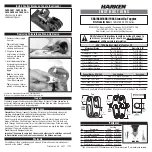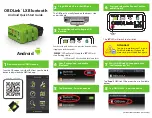
Outline Notes
1. Recommended direction of air flow if required.
2. Anode temperature measured at this point.
3. With surface A resting on a flat surface plate, a feeler
gauge 0.51 mm thick and 3.18 mm wide will not enter more
than 3.18 mm at any point.
4. Surface A and interior surfaces of the waveguide will be
plated with 1.55 mg/cm
2
of gold or 4.65 mg/cm
2
of silver,
but will not be plated if the parts are made of monel or
equivalent corrosion resistant materials. All other metal
surfaces will be painted with heat resistant paint or
otherwise treated to prevent corrosion.
5. Reference plane C intersects plane B at the centre of the
mounting plate hole as shown and is mutually perpendi-
cular to reference planes A and B.
6. These holes will lie within 0.127 mm of the indicated
centres. A cylinder of 8.38 mm diameter and centred on
these holes will clear the side of the magnet.
7. The position of the waveguide hole is not specified on this
drawing since tubes are tested and used with coupler
UG-40B/U (NATO S.N. 5985-99-083-0051).
8. The centre of this hole will lie within 0.102 mm of reference
plane C.
9. Reference plane B passes through the centres of the two
holes of the mounting plate as shown and is perpendicular
to reference plane A.
10. The north seeking pole of the magnet will be adjacent to
the cathode sidearm.
11. Length of flying leads measured from the centre line of the
anode block.
HEALTH AND SAFETY HAZARDS
e2v technologies magnetrons are safe to handle and operate,
provided that the relevant precautions stated herein are
observed. e2v technologies does not accept responsibility for
damage or injury resulting from the use of electronic devices it
produces. Equipment manufacturers and users must ensure that
adequate precautions are taken. Appropriate warning labels and
notices must be provided on equipments incorporating e2v
technologies devices and in operating manuals.
High Voltage
Equipment must be designed so that personnel cannot come
into contact with high voltage circuits. All high voltage circuits
and terminals must be enclosed and fail-safe interlock switches
must be fitted to disconnect the primary power supply and
discharge all high voltage capacitors and other stored charges
before allowing access. Interlock switches must not be
bypassed to allow operation with access doors open.
RF Radiation
Personnel must not be exposed to excessive RF radiation. All
RF connectors must be correctly fitted before operation so that
no leakage of RF energy can occur and the RF output must be
coupled efficiently to the load. It is particularly dangerous to
look into open waveguide or coaxial feeders while the device is
energised. Screening of the cathode sidearm of high power
magnetrons may be necessary.
X-Ray Radiation
High voltage magnetrons emit a significant intensity of X-rays
not only from the cathode sidearm but also from the output
waveguide. These rays can constitute a health hazard unless
adequate shielding for X-ray radiation is provided. This is a
characteristic of all magnetrons and the X-rays emitted
correspond to a voltage much higher than that of the anode.
Printed in England
#
e2v technologies
MG5239T, page 5
Whilst e2v technologies has taken care to ensure the accuracy of the information contained herein it accepts no responsibility for the consequences of any use
thereof and also reserves the right to change the specification of goods without notice. e2v technologies accepts no liability beyond that set out in its standard
conditions of sale in respect of infringement of third party patents arising from the use of tubes or other devices in accordance with information contained herein.























